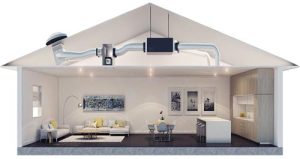The Role of Nasal Endoscopy in Diagnosing a Deviated Septum

A deviated septum can narrow one or both nasal cavities causing symptoms of congestion. It can also block sinus drainage pathways, predisposing patients to develop sinusitis symptoms.
A nasal endoscopy is a quick, easy procedure. You will sit upright and your healthcare provider will numb the area with an anesthetic.
Symptoms
If you have a deviated septum, you may experience nasal congestion, nosebleeds, and other symptoms. You can discuss these symptoms with your primary care doctor or an ear, nose, and throat specialist (also called an ENT). Your healthcare provider will want to ask you about your medical history. This includes any surgeries, especially nasal or sinus surgery, as well as any trauma to the nose. It’s also important for your doctor to know whether you have had any allergies or sinus infections.
Your healthcare provider will likely perform a nasal endoscopy to get a closer look at your septum. This is done while you’re in a seated position. Your healthcare provider will first spray a topical decongestant in your nose to reduce swelling and make the exam easier. Next, the healthcare provider will insert the endoscope into one nostril and then move it throughout the nasal and sinus passages, checking for any abnormalities. The healthcare provider will also be able to take tissue samples for further testing, if needed.
Based on these tests, your healthcare provider can determine the severity of your deviated septum and make a treatment plan. For example, your doctor might recommend medications to manage your symptoms, such as antihistamines and prescription nasal steroid sprays. In some cases, your doctor might suggest that you have surgery to correct the septum and relieve your symptoms.
Diagnosis
A deviated septum can cause nasal congestion, snoring and sleep apnea. It can also lead to sinus infections, headaches and facial pain. If you suffer from these symptoms, visit Penn Medicine Becker ENT & Allergy to see if your deviated septum is the root of the problem.
Your doctor will take a medical history and do a physical exam. He or she may use a handheld tool (nasal speculum) to gently open one nostril and look inside. Your provider will also use a nasal endoscope, a thin, lighted tube with a camera at the tip. This allows your provider to see the structure of your nose and sinuses, as well as other areas that could be causing symptoms, such as swelling, polyps or discharge.
If your crooked septum is causing symptoms, surgery may be necessary to correct the deviation and improve breathing. This procedure is called septoplasty. During the procedure, your provider will remove excess bone or cartilage from the septum to make it a more even shape and improve airflow through both nostrils. The operation may be performed in the office or in a hospital. After the procedure, your provider will leave a soft splint in your nose to help stabilize it. The splint will be removed after three to four days. You may experience some swelling or bruising for a week or two after the operation.
Treatment
A crooked or off-center nasal septum can cause symptoms such as sinus headaches, chronic nasal congestion and breathing difficulties. The condition can be hereditary or develop after injury such as a blow to the nose, playing sports or getting into an accident. A deviated septum may also lead to snoring and sleep problems.
A deviated septum can be treated with medication or surgery. Medication includes nasal steroid sprays, antihistamines and decongestants to control allergies and inflammation. These medications can help relieve congestion and headaches caused by a clogged or congested nose, but they cannot correct the misalignment of the nasal septum. Surgery to repair a skewed or crooked nasal septum is known as a septoplasty. It can improve breathing, reduce snoring and decrease the frequency of sinus infections. The procedure can be done on an outpatient basis in the office and takes about a week to recover.
Children who have a deviated septum should be seen by an otolaryngologist, or ear, nose and throat specialist, to determine the best treatment. In some cases, a child’s family physician or pediatrician can manage the child’s symptoms until the underlying problem has been corrected by an otolaryngologist. If your child has a deviated septum, an otolaryngologist will perform nasal endoscopy to obtain more information about the condition and recommend treatment.
Follow-up
Using nasal endoscopy, doctors can take out polyps, foreign objects and other masses from the nose and sinuses. They can also remove tissue to send off for further testing. In one study, the procedure was found to be superior to a nasal brush for collecting specimens for microbiology and pathology.
The procedure is typically done in the office and takes only a few minutes to perform. Your healthcare provider will numb the area with a topical decongestant before inserting the endoscope.
After the numbness wears off, the doctor will slide the endoscope into one nostril and guide it through the nasal and sinus passages. Images of the area can then be seen on a monitor and small tools can be used to remove or collect samples.
The results of the endoscopy can help the doctor create a treatment plan. The doctor may want to schedule a follow-up appointment for the patient or order more tests, like a CT scan. In some cases, the patient will be able to go home right after the endoscopy. The patient should follow any instructions the healthcare provider gives and call the office if they have a severe nosebleed that does not stop. In the future, the patient should be sure to avoid taking blood thinners before nasal endoscopy. This is because the blood thinners can increase the risk for bleeding during or after the procedure.







